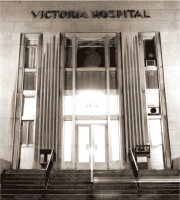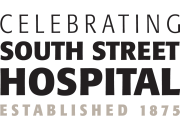1946-1969: The Post War Years
1930–19451970–1989Hospital Expansion
As early as 1946, hospital administrators recommended no fewer than 200 new beds be added to the hospital. Victoria Hospital was experiencing a growing demand for hospitalization due to the more government grants for teaching hospitals, the sponsoring of blood and plasma to hospitals by the Red Cross, the increase in expanding cancer care and the Ontario program for prepaid hospitalization plans.
More Information
The Hospital Trust planned for a new Y-shaped, six-storey addition to be built behind the North Wing. However, the uncertain availability of post-war building materials and labour costs caused delays in funding and approval of new construction plans.
In May 1953, City Council approved the Y-wing addition, with two more floors for an eight-storey building. The construction delay had rendered the original plans insufficient to meet the needs of the community.
Programs and services in the new addition included the new Ontario Cancer Foundation Clinic, a chapel, various laboratories, lecture rooms, additional surgical recovery rooms, new nurseries and an enlarged maternity department. The seventh floor was reserved for psychiatric patients.
In 1954, a special dedication service was held in the chapel with 250 guests in attendance. The floor of the chapel was carpeted wall to wall with the gold carpet that was used at the Coronation of Queen Elizabeth II.
The continued growth of the hospital again created an acute need for additional patient care facilities. As well, some areas of Victoria Hospital were showing their age very badly. In 1964, the Ontario Hospital Services Commission approved an eight-storey, $1,750,000 addition to the east section of the hospital’s Y-wing. Some 110 more beds were provided when the Middlesex Wing opened in the summer of 1967, but more importantly the outdated facilities in the Colborne Wing were replaced.
Medical Innovation at Victoria Hospital
In addition to hospital expansion, Victoria Hospital participated in significant medical innovation. In 1949, Dr. Murray Barr and his research team discovered the Barr Body on chromosomes which lead to simple genetic testing even before the discovery of DNA.
In the spring of 1948, Dr. Jacobus van Noordwjik, who had worked under Dr. Kolff in Holland, spent a year in London instructing physicians how to build and operate the first artificial kidney machine in Canada.
On October 27, 1951, the first treatment in the world with Cobalt-60 radiation took place at the Ontario Institute of Radiation at Victoria Hospital with Dr. Ivan Smith as the attending physician. Developed by Dr. Smith and built in Saskatoon, the machine was known as the “Cobalt Bomb” or the “Peace Bomb”. Its first use was recorded by the CBC.
Dr. Charles Drake was the Chief of Neurosurgery at Victoria Hospital in 1953. He developed and perfected his techniques for the diagnosis and repair of brain aneurysms, gaining international recognition.
Excerpts from "Growing to serve... : a history of Victoria Hospital, London, Ontario." Authors: Norman. John Robert Sullivan, Norman R. Ball, and Victoria Hospital Corporation. Published: 1985 by Victoria Hospital Corporation, London, Ontario.







